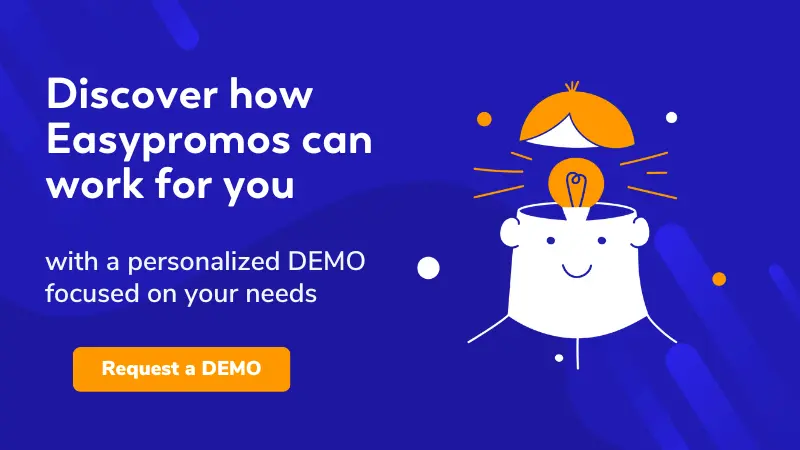The Power of Multiple Choice Tests in Interactive Marketing Promotions
Marketing in the digital age is all about engagement. It’s not enough to just present your audience with information; you need to interact with them, make them feel involved, and ultimately guide them towards a desired action. Enter the multiple choice test, a simple yet powerful tool that can elevate your marketing promotions to a whole new level.
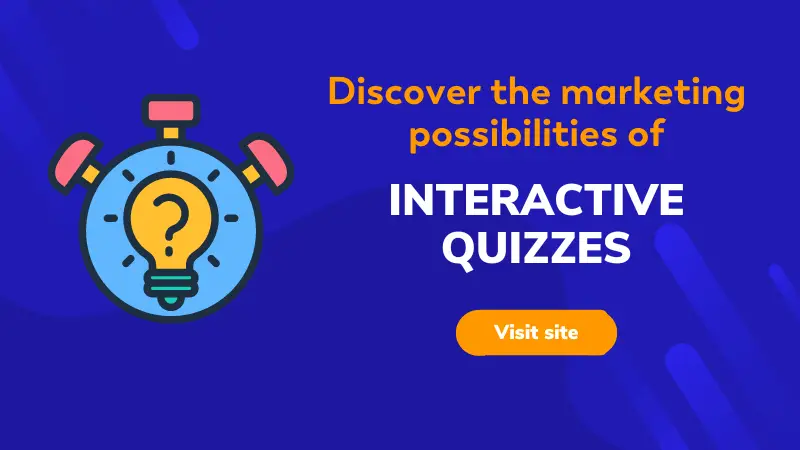
You might be wondering, “Multiple-choice tests? Aren’t those just for school exams?” Well, think again! In the world of interactive marketing, a multiple-choice test can serve as an engaging and versatile promotional tool, offering a unique way to connect with your audience, gather valuable data, and drive conversions. Let’s dive into why and how you should be using these tests in your marketing strategy.
Why a Multiple Choice Test Works
Interactive and Engaging
The beauty of multiple-choice tests lies in their ability to engage users in an active way. Unlike static content, such as blog posts or infographics, a quiz or test demands participation. When someone takes a multiple-choice test, they’re not just passively consuming information—they’re actively involved in the experience. This interaction helps to create a deeper connection with your brand, making it more memorable.
Easy to Create and Share
Creating a multiple-choice test is relatively easy and, if you are using Easypromos, doesn’t require programming skills. Once created, these tests are also incredibly shareable. Social media platforms, email newsletters, and even your website can serve as perfect outlets for promoting your quiz, allowing you to reach a wider audience with minimal effort.
Data Collection Goldmine
One of the biggest advantages of using multiple-choice tests in marketing is the data collection potential. Every answer a participant gives can provide insight into their preferences, behaviors, and needs. This data is invaluable for crafting more personalized and targeted marketing campaigns down the line. By analyzing the responses, you can segment your audience more effectively and deliver tailored content that resonates with them on a deeper level.
Boost Lead Generation
Multiple-choice tests are not just fun and games; they can be serious tools for lead generation. By asking participants to fill out a registration form before they see their results, you can easily capture new leads. This approach is particularly effective because it feels more like an exchange of value—the participant gets to enjoy the quiz and learn something about themselves, and you get valuable user data for future marketing efforts.
Choosing the Right Multiple Choice Test Maker
These are all valid and desirable marketing objectives. However, there is a crucial decision to be made. Which multiple choice test maker from among those in the market should you choose? Here are some key issues that you should look for to be able to achieve your objectives:
- Ease of use. One of the most important factors is the tool’s usability. You want a platform that offers a user-friendly interface and does not require programming skills.
- Customizable registration forms. As this is where data collection takes place, being able yo decide which information fields to include in the Quiz registration form is paramount. Make sure you can include text fields, drop down menus, and check boxes at the very least.
- Customization options. Your multiple choice test should reflect your brand’s identity, from the design and layout to the tone of the questions. Look for a tool that allows for extensive customization: color schemes, fonts, logos, buttons, background images, etc. This ensures that your quiz not only engages users but also reinforces your brand image.
- Integration capabilities. The ability to integrate with your existing marketing stack is another key consideration. Whether you’re using CRM software, email marketing platforms, or social media tools, your multiple-choice test platform should easily connect with these systems. This integration is vital for automating data collection, lead nurturing, and follow-up actions.
- Analytics and reporting. Data is the backbone of any successful marketing campaign. Choose a tool that offers robust analytics and reporting features that provide insights into user preferences and behaviors. This will help you refine your strategies and improve future campaigns.
- Mobile responsiveness. Make sure that your multiple-choice tests look and function seamlessly across all screen sizes, providing a smooth and engaging user experience.
Among the many options available, Easypromos ticks all these boxes and more! Create engaging, data-driven campaigns that resonate with your audience and drive meaningful results.
Examples of Multiple Choice Tests
Now that we’ve covered the “why,” let’s dive into some real-world examples of how to use them effectively in marketing. Your multiple choice test can be presented if different formats and each serves a different marketing objective—whether it’s to gather data, drive sales, enhance engagement, or build brand awareness. By choosing the right format and aligning it with your specific goals, you can create powerful marketing campaigns that resonate with your audience and achieve meaningful results.
Personality Quiz
A personality quiz is a highly effective type of multiple-choice test that can be easily customized to align with your brand. For instance, a home decor brand might develop a quiz called, “What’s Your Christmas Decor Style?” This quiz would prompt users to answer questions about their color preferences, design aesthetics, and the overall vibe they want for their holiday decorations. At the end of the quiz, participants would receive a tailored recommendation for their ideal Christmas decor style, along with a link to shop for suggested items. This approach not only captivates users but also promotes direct sales.
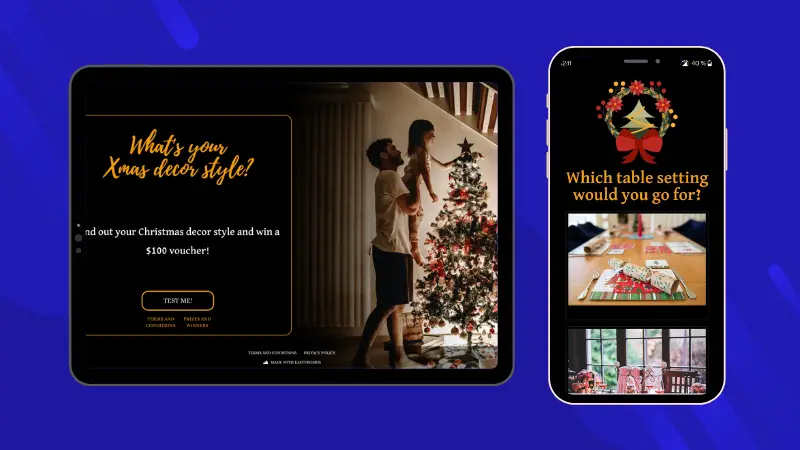
Try this Christmas Personality Quiz DEMO for the full user experience!
Knowledge Quizzes and Trivia
A Knowledge Quiz can be a great way to educate your audience while subtly promoting your products or services. For instance, a wine cellar might develop a quiz titled, “Are you a wine expert?” Participants would answer questions about various types of wines, grape varieties, and wine regions. At the end of the quiz, the results could suggest wine selections or special tasting events related to the wines featured, leveraging the user’s increased interest in wine.
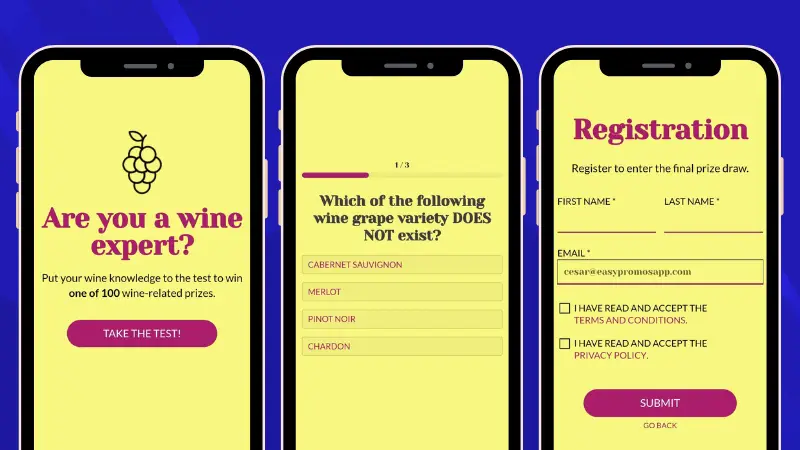
Product Recommender
A product recommender quiz is designed to help users find the perfect product that meets their needs. For example, a gift shop could offer a quiz titled, “What’s the Best Gift for Dad on Father’s Day?” The quiz would ask questions about your dad’s hobbies, interests, and preferences, such as whether he enjoys cooking, technology, or outdoor activities. Based on the responses, the quiz would recommend the ideal gift options tailored to your dad’s unique personality, with direct links to the product pages for easy purchasing.
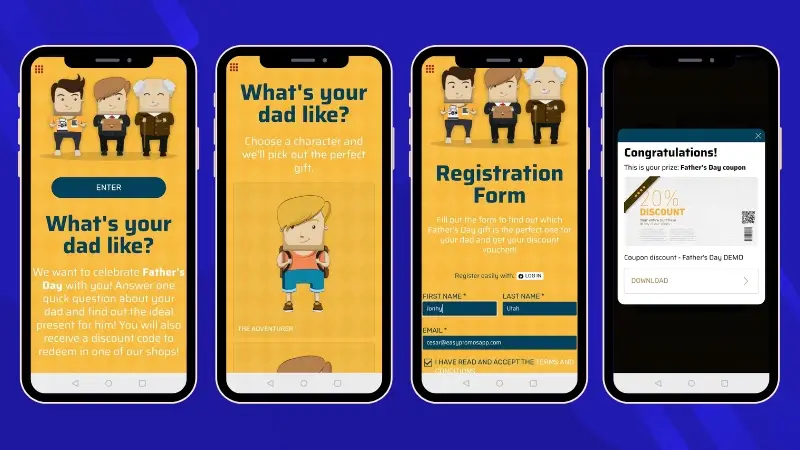
Survey Quiz
A Survey is a strategic way to better understand your audience and tailor content to their specific interests. For example, a bookstore might create a survey titled, “What’s Your Favorite Literary Genre?” The survey would ask participants about their reading preferences, favorite authors, and preferred book formats. Based on their responses, the bookstore could segment the audience into different groups, such as those who love mystery novels, fantasy enthusiasts, or fans of historical fiction. This segmentation allows the bookstore to send highly targeted follow-up content, such as personalized book recommendations or exclusive offers, ensuring that each reader receives content that resonates with their literary tastes.

How to Create an Effective Multiple Choice Test
Ready to jump on the multiple-choice test bandwagon? Here are some tips to ensure your test is both engaging and effective:
- Know Your Audience. What are their interests, pain points, and motivations? The more you know about your audience, the more relevant and appealing your test will be.
- Craft Compelling Questions. Your questions should be clear, concise, and interesting. Avoid making them too easy or too difficult—striking the right balance is key to keeping users engaged. Also, be sure to keep the tone conversational and aligned with your brand voice.
- Incorporate Visuals. Adding images or videos to your test can make it more visually appealing and enhance the user experience. For example, if you’re creating a product match quiz, include images of the products in the answer options.
- Provide Value. Your quiz should offer something valuable in return for the participant’s time. This could be personalized recommendations, a fun result that they can share with friends, or even better, a discount code at the end of the quiz. The more value you provide, the more likely participants are to complete the test and share it with others.
- Optimize for Mobile. Many users will take your test on their smartphones, so it’s important to ensure that the experience is seamless across all devices. Make sure your quiz is mobile-friendly, with easy-to-tap answer options and fast loading times.
Use Cases: Where and When to Deploy Your Multiple Choice Test
Multiple-choice tests can be used at various stages of the customer journey, from awareness to conversion. Here are some scenarios where they shine:
Top of Funnel (Awareness)
At the top of the funnel, you can use quizzes to attract new audiences. For example, a financial planning firm might create a quiz like, “How Prepared Are You for Retirement?” to engage users who are just beginning to think about their financial future. This type of quiz helps introduce your brand and start the conversation with potential customers.
Middle of Funnel (Consideration)
In the consideration phase, multiple-choice tests can help prospects narrow down their choices and find the right product. For example, a home appliance company could offer a quiz titled, “Which Coffee Maker Fits Your Morning Routine?” This quiz would ask about brewing preferences, kitchen space, and budget, then guide users to the coffee maker that aligns best with their needs. By offering tailored suggestions, the quiz simplifies the decision-making process, making it easier for customers to choose the perfect appliance for their home.
Bottom of Funnel (Conversion)
Finally, at the bottom of the funnel, you can use quizzes to nudge prospects towards a purchase. For example, a furniture retailer might create a quiz titled, “Which Sofa Style Matches Your Living Room?” The quiz could ask about the user’s space dimensions, color preferences, and design tastes, then link the results directly to product pages featuring recommended sofas. By offering tailored suggestions, the quiz helps customers find the perfect fit for their home, making it easier to drive conversions and close the sale.
Conclusion
In the world of interactive marketing, multiple-choice tests are an incredibly effective tool for engaging your audience, collecting valuable data, and driving conversions. While there are many tools available to create and manage these campaigns, Easypromos provides you with all the necessary features necessary to make your campaign a resounding success.
If you have any question regarding our platform or applications, don’t hesitate to contact us via live chat. We will be happy to help!
